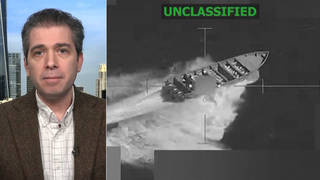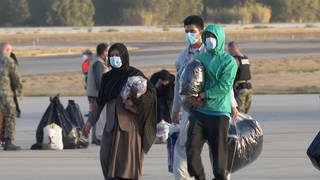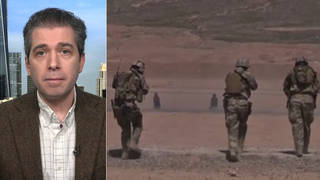
Topics
We speak with UPI’s Mark Benjamin who reveals that new Pentagon data puts the number of U.S. casualties since the beginning of the Iraq invasion–including troops killed, wounded or evacuated due to injury or illness — at over 9,000, a significant increase over earlier estimates. [Includes transcript]
Click here to read to full transcript In his latest report, United Press International’s investigations editor Mark Benjamin finds that the number of U.S. casualties since the beginning of the invasion of Iraq has passed 9,000–according to new Pentagon data. The figure includes troops killed, wounded or evacuated due to injury or illness.
In addition to the over 400 soldiers killed and some 2,000 wounded, nearly 7,000 troops were medically evacuated for non-combat conditions as of October 30, according to the Army Surgeon General’s office. This represents an increase of nearly 3,000 non-combat medical evacuations reported since the first week of October. The Army has offered no immediate explanation for the increase.
Joining us on the phone right now from Washington DC is Mark Benjamin. His Oct. 17 piece for UPI exposed the substandard conditions of sick and wounded soldiers in Fort Stewart. Sen. Kit Bond (R-MO) credited the piece for triggering big improvements in medical care for hundreds of sick and wounded soldiers.
- Mark Benjamin, UPI Investigations editor. His Oct. 17 piece exposed the conditions of sick and wounded soldiers in Fort Stewart. Sen. Kit Bond (R-MO) credited the piece for triggering big improvements in medical care for hundreds of sick and wounded soldiers.
TRANSCRIPT
AMY GOODMAN: Welcome to Democracy Now!, Mark Benjamin.
MARK BENJAMIN: Thank you for having me.
AMY GOODMAN: Let’s start off with the issue of casualties. We’re not hearing that figure from the White House. 9,000 casualties?
MARK BENJAMIN: We have not heard that figure. I don’t know why. We did get the numbers directly from the Pentagon. It’s not that the Pentagon as far as I can tell is making any effort to hide the figures. They’re also not making any effort to publicize the figures. It’s up to reporters frankly to ask the right questions and ask them repeatedly until they get the answers.
AMY GOODMAN: How did you calculate your figures?
MARK BENJAMIN: Well, the figures are calculated based on Pentagon numbers. Obviously, one of the numbers that the Pentagon just hasn’t been talking about a lot is the number of troops that get sick or are injured in battle, but — or at least serving. I should say serving in “Operation Iraqi Freedom” but don’t get counted in those daily totals. The Pentagon every day announces soldiers who are killed. Most of the people who are injured in a major campaign aren’t the people that are hurt from Iraqi bullets are the people that get hurt, that hurt their backs or get severely ill from whatever happens to be the ailment at the time. We simply ask the questions what are the overall casualties. Casualties are the people who get hurt or injured and can no longer serve. We’re trying to find out what the overall number is.
AMY GOODMAN: What about how casualties are categorized?
MARK BENJAMIN: That’s an interesting question. It’s something we’re trying to learn more about. I think it’s safe to say that we can tell relatively little about what is happening to the troops in Iraq based on the numbers that are released from the Pentagon. Even these non-combat casualties — while the Pentagon has broken them down into general surgeries and neurosurgeries and so on, we really don’t no what troops are suffering from in this war. It’s something that I think veterans groups are starting to take note of.
AMY GOODMAN: You quote Steve Robinson, who is the Executive Director of the National Gulf War Resource Center. He says that he’s especially concerned about the psychological and neurological evaluations from the war and are requesting clarification on the types of illnesses that people are suffering from.
MARK BENJAMIN: That’s right. There are in the data that we received — the latest data that we received from the Pentagon, there are a little over 500 psychiatric evaluations which are people that have mental problems bad enough they need to be put on airplanes. There are hundreds of other evacuations for neurosurgery and neurological problems. We don’t know what those are. The Pentagon so far hasn’t told us. Perhaps they will. I hope they will. We don’t know what that means. We don’t know if those are just brain injuries. We don’t know — there’s a gamut of possible explanations, even the fact that, frankly, some of the troops in Iraq are taking a very, very potent malaria drug. I know it sounds far-fetched but there are soldiers who say they have had brain problems because of the malaria drug called larium. We just don’t know what is happening with the brain problems.
AMY GOODMAN: Would the administration also be interested in classifying casualties more as non-combat casualties because then you don’t have those numbers adding up of the dead and the wounded?
MARK BENJAMIN: There are certainly people who worry that that is the case. I have seen no evidence so far in my reporting to indicate anything other than that the Pentagon tries to categorize illnesses and injuries as accurately as they possibly can. Having said that, it is certainly something we are going to pay close attention to in the future.
AMY GOODMAN: Now on this end, when wounded soldiers come home. Mark Benjamin of U.P.I is our guest and has done several pieces on the sick and wounded at Fort Stewart, Georgia, being credited by senators for changing the conditions there having more help sent in. Can you talk about what’s happened at Fort Stewart?
MARK BENJAMIN: Well, what has happened at Fort Stewart, as you know, at that particular base, there were a little over 600 soldiers on what they called medical hold. These are national guard and army reserve soldiers, many of whom returned from Iraq who were waiting weeks and months for doctors and staying in what people think was substandard housing with no running water. The Pentagon has flown in a team of doctors. They are moving more money to Ft. Stewart. They have taken several hundred of the soldiers in the worst barracks there and have moved them to other bases. The Pentagon is revisiting the policy at how quickly it can get doctors to soldiers awaiting treatment at bases. Quite a bit has happened. Senator Bond and Senator Leahy from Vermont are saying they’re going to pursue this very aggressively, which I’m glad to hear.
AMY GOODMAN: You can describe the conditions that they were held in and how it was it took so long for the military to take care of their own?
MARK BENJAMIN: The conditions at Ft. Stewart there were as I said, 633 I think the time I visited Ft. Stewart last month. Many of the soldiers were in barracks built in world war ii era for training purposes. These were one-room cement barracks with no air conditioning, which is a problem in southern Georgia, as you can imagine. No running water. The soldiers were kept in bunk beds. They have no private place to put their belongings. They have to walk outdoors to go to the bathroom, which is a common bathroom which most people don’t like. These are probably fine for training. Not okay, I think, for injured troops or wounded troops and so on. But the biggest — the biggest complaint, and I heard this at Ft. Knocks as well, is long, long waits, weeks and months, believe it or not, to go see doctors or found or illnesses. I think that bothered soldiers the most.
AMY GOODMAN: Well, I want to thank you very much for being with us, Mark Benjamin, the Investigations Editor for U.P.I United Press International.
MARK BENJAMIN: Thank you for having me.











Media Options